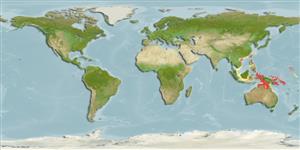>
Cichliformes (Cichlids, convict blennies) >
Pholidichthyidae (Convict blenny)
Etymology: Pholidichthys: Greek, pholis, -idos = scale (Ref. 45335); anguis: Specific name from the Latin 'anguis' meaning snake, referring to the elongate form, and is here used as Noun in apposition.
More on authors: Springer & Larson.
Environment: milieu / climate zone / depth range / distribution range
Ecologia
marino demersale; distribuzione batimetrica 19 - 70 m (Ref. 26419). Tropical
Western Central Pacific: Northern Territory, Australia.
Size / Peso / Age
Maturity: Lm ? range ? - ? cm
Max length : 24.5 cm SL (female)
Raggi dorsali molli (totale) : 86 - 98; Raggi anali molli: 70 - 81.
Specimens collected using benthic trawl, from a muddy substrate which include sand, shell, sponges, and rocky reef and coral patches (Ref. 26419).
Life cycle and mating behavior
Maturità | Riproduzione | Deposizione | Uova | Fecundity | Larve
Springer, V.G. and H.K. Larson, 1996. Pholidichthys anguis, a new species of pholidichthyid fish from Northern Terrotory and Western Australia. Proc. Biol. Soc. Wash. 109(2):353-365. (Ref. 26419)
IUCN Red List Status (Ref. 130435: Version 2024-1)
Threat to humans
Harmless
Human uses
Strumenti
Special reports
Download XML
Fonti Internet
Estimates based on models
Preferred temperature (Ref.
123201): 26.5 - 28.6, mean 27.5 °C (based on 92 cells).
Phylogenetic diversity index (Ref.
82804): PD
50 = 1.0000 [Uniqueness, from 0.5 = low to 2.0 = high].
Bayesian length-weight: a=0.00102 (0.00046 - 0.00225), b=3.06 (2.88 - 3.24), in cm total length, based on all LWR estimates for this body shape (Ref.
93245).
Trophic level (Ref.
69278): 3.5 ±0.5 se; based on size and trophs of closest relatives
Fishing Vulnerability (Ref.
59153): Low vulnerability (20 of 100).
Nutrients (Ref.
124155): Calcium = 191 [118, 325] mg/100g; Iron = 1.09 [0.69, 1.72] mg/100g; Protein = 17.8 [16.9, 18.6] %; Omega3 = 0.161 [0.090, 0.280] g/100g; Selenium = 52.7 [27.7, 99.4] μg/100g; VitaminA = 28.3 [10.4, 72.7] μg/100g; Zinc = 1.37 [1.01, 1.87] mg/100g (wet weight);
